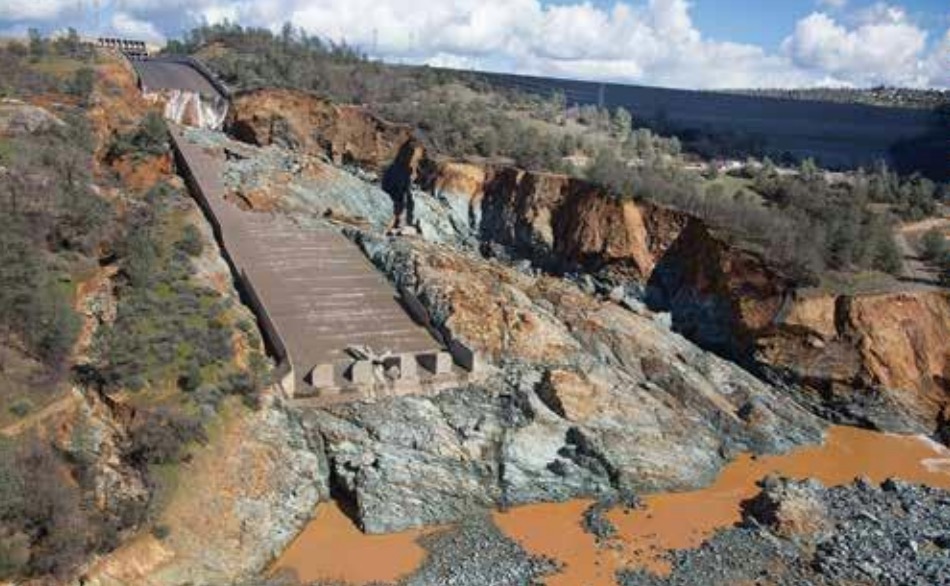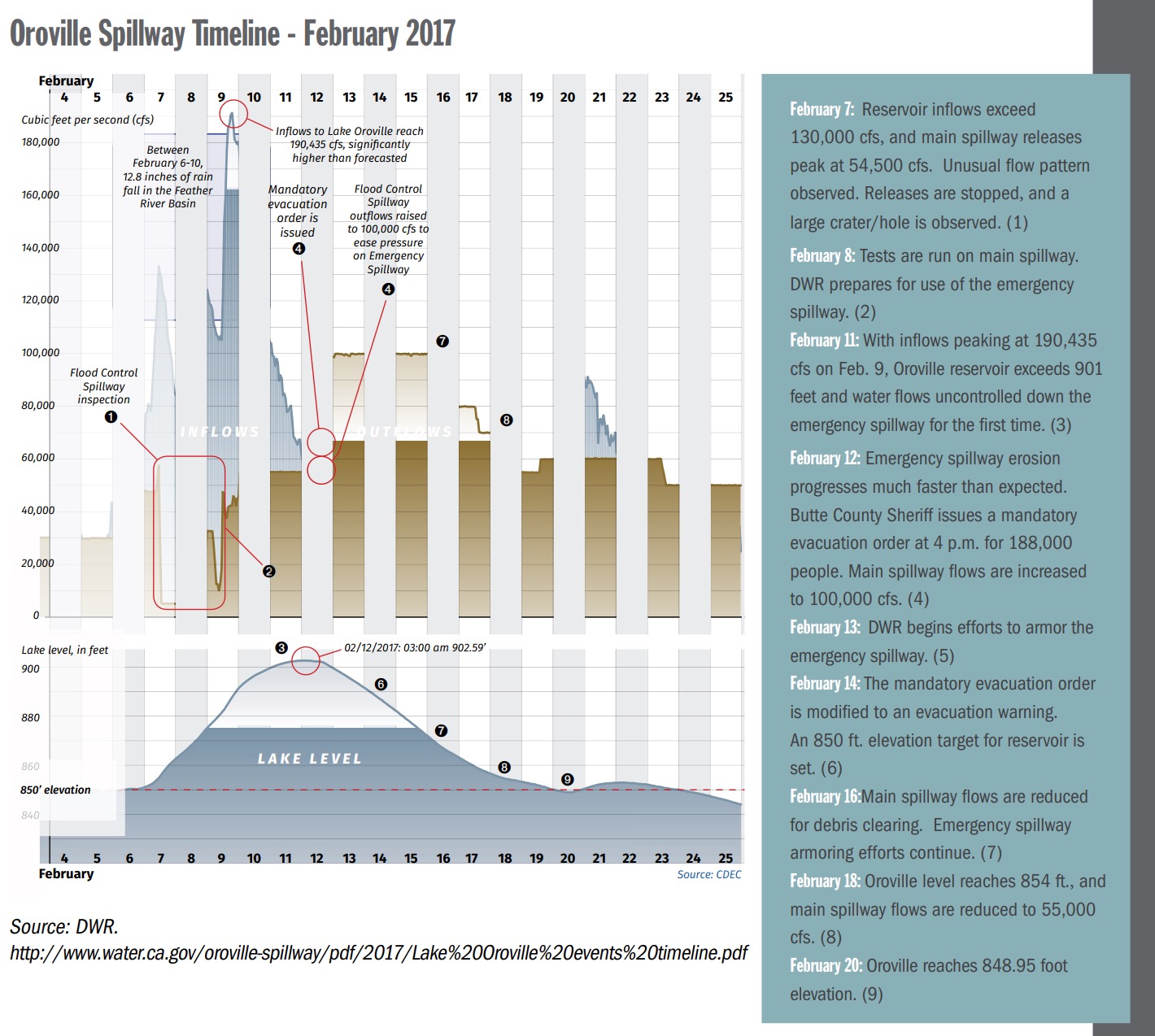FRIENDS OF THE RIVER
CALIFORNIA SPORTFISHING PROTECTION ALLIANCE
AMERICAN WHITEWATER
The 2017 Oroville Dam Spillway Incident, and Lessons from the Feather River Basin
Executive Summary
 Oroville Dam gained worldwide attention in February 2017 when crumbling spillways at the nation’s tallest dam triggered one of the largest evacuations in California history. The near catastrophe remains a socioeconomic blow to downstream communities.
Oroville Dam gained worldwide attention in February 2017 when crumbling spillways at the nation’s tallest dam triggered one of the largest evacuations in California history. The near catastrophe remains a socioeconomic blow to downstream communities.
While some repair work is moving forward at Oroville, significant issues remain to be addressed. This incident is a wake-up call for action on several fronts at this facility and thousands of other high-hazard dams in the United States to ensure a safe and reliable water system that protects communities and the rivers that flow through them. A warming climate with changing precipitation patterns underscores the urgency.
The 2017 Oroville Dam Spillway Incident: Lessons from the Feather River Basin calls for action on 18 recommendations, and dozens of sub-recommendations, to address California’s aging dam infrastructure, operate dams more safely and efficiently, advance multi-benefit flood management projects, and increase transparency and public engagement.
A chief recommendation is the need for a complete emergency spillway at Oroville Dam. At this time, there is no evidence that the Department of Water Resources plans to address this fundamental problem. The report also identifies several other dams in California that require investment in maintenance, repair, or reconstruction.
Improving dam operations is also critical to avoiding another incident like Oroville. This requires better flood modeling and scheduled updates of flood-control manuals with opportunities for robust public involvement. The Federal Energy Regulatory Commission (FERC) should also address dam safety issues as a part of relicensing hydropower projects. In the San Joaquin Basin, studies need to explore opportunities to increase maximum controlled flood flows from facilities like Don Pedro Dam on the Tuolumne River.
The report has several recommendations to reduce downstream risk in the event of flooding or infrastructure failure, through multi-benefit flood management projects. Funding the Central Valley Flood Protection Plan is critical to implementing several of these projects, such as the expansion of the Yolo Basin Bypass and the weirs that allow Feather River/Sutter Bypass and American River flood flows into the Yolo Bypass. Expanding the floodplain in the Oroville Wildlife Area and implementing the Lower Feather River Corridor Management Plan are also priorities in the Sacramento Basin. In the San Joaquin Basin, reservoir-based floodwater management is far less reliable than in the Sacramento Basin. This problem will only get worse as precipitation patterns shift with climate change. Key projects there include setback levees and a small San Joaquin River floodwater bypass in the lower Delta.
Finally, the report calls for a shift in the relationship between out-of-area water project developers and members of the local communities that house those projects. This relationship should be based on equality, fairness, respect, and transparency. In the case of Oroville, and similar projects, this requires public release of forensic investigations, new inundation maps, and Emergency Action Plans, combined with comprehensive assessments of impacts and mitigation actions for communities like Oroville.
The main lessons from the Oroville Incident and a summary of recommendations are provided in the following table.
Lesson: California’s dam infrastructure is aging and needs to meet modern standards
Recommendations Summary
- Complete planned reconstruction of the Oroville main spillway and relocation of power-line transmission towers and lines.
- Plan a real auxiliary/emergency spillway that does not risk large quantities of hillside soil and rock being eroded into the Feather River.
- Conduct a thorough review of the Oroville Dam complex’s physical deficiencies and undertake appropriate upgrades.
- Systematically inspect dams across California and the U.S. to meet upgraded design and maintenance standards and procedures.
Lesson: Dam operations need periodic reviews
Recommendations Summary
- Update flood-control manuals for the Feather and Yuba River Basins.
- Re-evaluate the duration and character of floods modeled to exist in the future and make necessary modifications.
- Provide public involvement in the manual update process.
- Require the Army Corps to review and update flood manuals for all jurisdictional dams on a defined schedule.
- Require FERC to include dam safety in hydropower relicensing.
Lesson: Floodplain capacity is limiting flood protection, environmental quality, and local economies
Recommendations Summary
- Fund and implement the Central Valley Flood Protection Plan.
- Assemble diverse stakeholders to define and plan floodplain improvements.
- Evaluate and design multi-benefit floodplain projects (e.g., setback levees) that increase flood protection while creating more floodplain habitat.
- Develop and implement plans to create greater floodway capacity in the San Joaquin Basin.
Lesson: People and communities matter
Recommendations Summary
- Complete forensic investigations at Oroville and release to the public.
- Conduct comprehensive assessment of impacts to the Oroville and adjacent communities from 2017 spillway incidents.
- Establish new opportunities for mitigation and community development.
- Develop and make public new inundation maps and Emergency Action Plans.
- Reform the relationships between out-of-area water developers and local communities to create partnerships based on equality, fairness and respect.
Download full version (PDF): The 2017 Oroville Dam Spillway Incident
About Friends of the River
www.friendsoftheriver.org
Friends of the River was founded in 1973 during the struggle to save the Stanislaus River from New Melones Dam. Following that campaign, we grew to become California’s statewide river conservation organization. Friends of the River is dedicated to preserving and restoring California’s rivers, streams, and their watersheds as well as advocating for sustainable water management.
About the California Sportfishing Protection Alliance
calsport.org
The California Sportfishing Protection Alliance (CSPA) is a 501(c)(3) non-profit public benefit conservation and research organization established in 1983 for the purpose of conserving, restoring, and enhancing the state’s water quality, wildlife and fishery resources and their aquatic ecosystems and associated riparian habitats.
About American Whitewater
www.americanwhitewater.org
Founded in 1954, American Whitewater is a national non-profit organization with a mission “to conserve and restore America’s whitewater resources and to enhance opportunities to enjoy them safely.” American Whitewater is a membership organization representing a broad diversity of individual whitewater enthusiasts, river conservationists, and more than 100 local paddling club affiliates across America. The organization is the primary advocate for the preservation and protection of whitewater rivers throughout the United States, and connects the interests of human-powered recreational river users with ecological and science-based data to achieve the goals within its mission.
Tags: American Whitewater, CA, California, California Sportfishing Protection Alliance, dam, Disaster, Flooding, Friends of the River, Oroville Dam, Oroville Dam Spillway Incident







 RSS Feed
RSS Feed